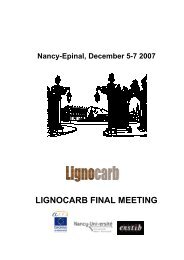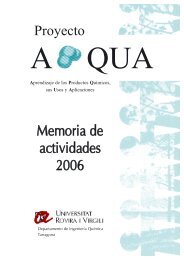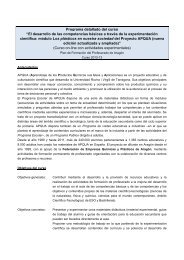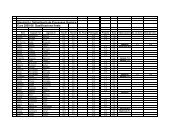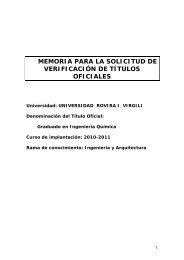A Transferable Force Field To Predict Phase Equilibria and Surface ...
A Transferable Force Field To Predict Phase Equilibria and Surface ...
A Transferable Force Field To Predict Phase Equilibria and Surface ...
Create successful ePaper yourself
Turn your PDF publications into a flip-book with our unique Google optimized e-Paper software.
The Journal of Physical Chemistry B ARTICLE<br />
Figure 1. Schematic representation of the ether function in the<br />
proposed molecular model. q1, q2, <strong>and</strong> q3 st<strong>and</strong> for the partial electrostatic<br />
charges located on the carbon <strong>and</strong> oxygen atoms.<br />
Figure 2. Experimental 15 gas phase dipole moments of ethers (diamonds:<br />
linear ethers, squares: branched ethers, circles: aromatic ethers, triangles:<br />
cyclic ethers).<br />
2.1.2. Electrostatic Energy. The electrostatic interaction between<br />
two partial electrostatic charges i <strong>and</strong> j is modeled by the<br />
Coulomb potential:<br />
U elec<br />
ij<br />
¼ qiqj<br />
4πε0rij<br />
ð5Þ<br />
where rij is the distance between charges i <strong>and</strong> j, qi the magnitude<br />
of charge i, <strong>and</strong> ε0 the vacuum permittivity.<br />
We adopt a three partial charge distribution involving one<br />
negative charge located on the oxygen atom <strong>and</strong> two symmetric<br />
positive charges on the bonded carbonated groups (see illustration<br />
in Figure 1). Concerning the magnitude of these charges, the<br />
use of a unique set of charges for the totality of the studied ether<br />
molecules is questionable. The transferability of electrostatic<br />
charges is justified as long as all studied molecules have a similar<br />
dipole moment. Figure 2 shows the evolution of the experimental<br />
gas phase dipole moment of various linear, branched, cyclic <strong>and</strong><br />
aromatic ethers in function of the number of carbon atoms. 15 In<br />
light of this graph, we propose to split the molecules in three<br />
groups. The first group (denoted further as group 1) contains<br />
branched <strong>and</strong> linear ethers (except dimethyl ether). The second<br />
group (group 2) contains dimethyl ether <strong>and</strong> aromatic ethers,<br />
<strong>and</strong> finally the third group (group 3) is constituted by cyclic<br />
ethers. Consequently, three different sets of partial electrostatic<br />
charges are proposed. It is well-known that the dipole moment of<br />
a polarizable molecule significantly differs between the gas phase<br />
<strong>and</strong> the liquid phase, <strong>and</strong> it is widely admitted that molecular<br />
models yield better results for phase equilibrium prediction when<br />
using the liquid phase dipole moment. 16 Hence, to determine the<br />
magnitude of the three sets of charges, we adopt a procedure<br />
similar to that described by Eckl et al.: 17,18 an ab initio calculation<br />
is performed by placing a molecule in a dielectric medium whose<br />
Table 2. Bonded Parameters for the AUA4 <strong>Force</strong> <strong>Field</strong><br />
bond length r0 (Å)<br />
CHx—CHy CHx—Oether/alcohol 1.535<br />
1.43<br />
1.36<br />
Carom—Oether CaromdCarom<br />
1.40<br />
Oalcohol—H 0.945<br />
bend θ0 (deg) kbend (K)<br />
CHx—CH2—CHy 114.0 74900<br />
CHx—CH2—Oether/alcohol 109.47 59800<br />
CHx—CH —Oether 112.0 57500<br />
CHx—C—Oether 112.0 57500<br />
CH x—O ether—CH y 112.0 69000<br />
CHaromdCHaromdCHarom 120.0 rigid<br />
CHaromdCarom—Oether/alcohol 120.0 rigid<br />
Carom—Oether—CHx 112.0 69000<br />
CHx—Oalcohol—H 108.5 61000<br />
torsion ai (K)<br />
CHx—CH2—CH2—CHy a0 = 1001.35 a1 = 2129.52<br />
a2 = 303.06 a3 = 3612.27<br />
a4 = 2226.71 a5 = 1965.93<br />
a6 = 4489.34 a7 = 1736.22<br />
a8 = 2817.37<br />
CHx—CH2—CH2—Oether a0 = 839.87 a1 = 2133.17<br />
a2 = 106.68 a3 = 3079.72<br />
CHx—CH2—CH2—Oalcohol a0 = 839.87 a1 = 2133.17<br />
a2 = 106.68 a3 = 3079.72<br />
CHx—CH2—Oether—CHy a0 = 956.05 a1 = 949.25<br />
a2 = 327.50 a3 = 2232.80<br />
CHx—CH2—Oether—Carom a0 = 956.05 a1 = 949.25<br />
a2 = 327.50 a3 = 2232.80<br />
CH3—CH—Oether—CHy a0 = 373.05 a1 = 919.04<br />
a2 = 268.15 a3 = 1737.21<br />
CH3—C—Oether—CHy a0 = 230.65 a1 = 691.92<br />
CHaromdCHaromdCHaromdCHarom rigid<br />
CHaromdCHaromdCarom—Oether/alcohol rigid<br />
a 2 =0 a 3 = 922.58<br />
rigid<br />
OalcoholdCaromdCarom—Oether<br />
CaromdCarom—Oalcohol—H a0 = 845.65 a1 =0<br />
a2 = 845.65 a3 =0<br />
CHaromdCarom—Oether—CHx a0 = 1631.27 a1 = 2651.77<br />
a2 = 868.86 a3 = 2184.14<br />
a4 = 3028.37 a5 = 3065.12<br />
a6 = 1926.79 a7 = 1723.03<br />
a8 = 497.96<br />
Oether—CH2—CH2—Oether a0 = 586.06 a1 = 2775.61<br />
a2 = 2496.45 a3 = 2542.12<br />
a 4 = 3132.43 a 5 = 2249.38<br />
a6 = 4188.47 a7 = 1318.58<br />
a 8 = 2316.03<br />
CH2—CH2—Oalcohol—H a0 = 339.41 a1 = 353.97<br />
a2 = 58.34 a3 = 751.72<br />
Oether—CH2—CH2—Oalcohol a0 = 1530.22 a1 = 4064.26<br />
a2 = 422.78 a3 = 5570.19<br />
10656 dx.doi.org/10.1021/jp203278t |J. Phys. Chem. B 2011, 115, 10654–10664



